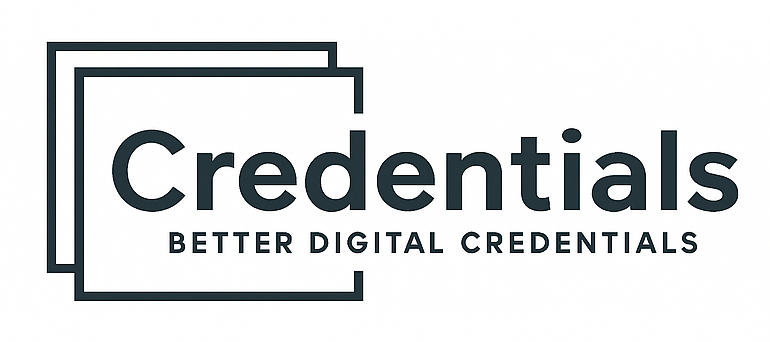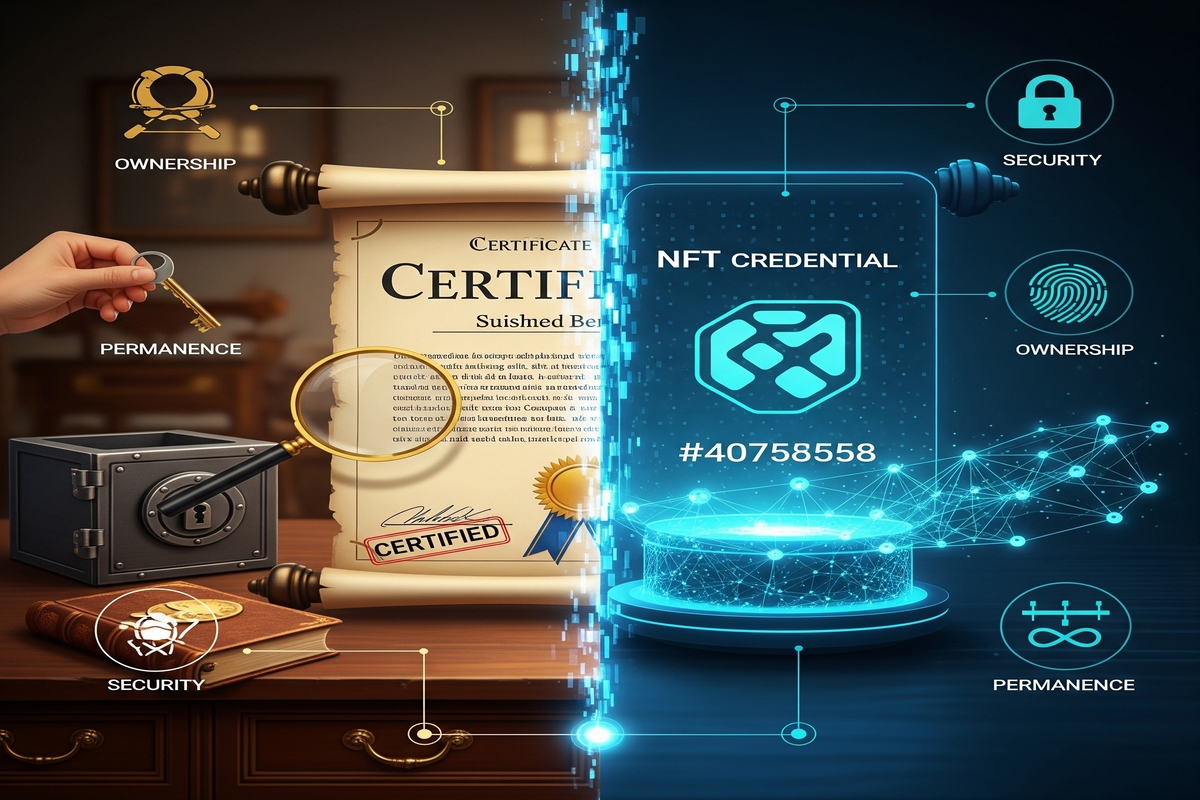The digital credential market is evolving fast, but there’s a huge gap between real blockchain credentials and the so-called “blockchain” solutions offered by many Web2 platforms.
In reality, most of these solutions are not on the blockchain at all — and their value for verification, ownership, and permanence is minimal. Let’s break down the difference and explain why NFTs are the only truly future-proof form of digital credentials.
1. Web2 Credentials: What They Really Are
Traditional credentialing platforms — even those claiming “blockchain technology” — usually operate in a centralized Web2 model:
- The credential is stored on the platform’s private database, not on a public blockchain.
- “Blockchain” often means they generate a hash or store metadata on a server, but the full credential is not on-chain.
- Verification still depends on the platform being online and granting access.
- If the company closes or changes its terms, the credential can disappear.
- Ownership remains with the platform, not the learner or earner.
In short: the term “blockchain” is used as marketing without real decentralization.
2. NFT Credentials: True Blockchain Ownership
An NFT credential is fundamentally different:
- Fully on-chain: The credential (or its essential data and verification proof) is minted as an NFT on a public blockchain such as Ethereum, Polygon, or LACChain.
- True ownership: The recipient owns the NFT in their own wallet — it’s theirs forever.
- Permanent verification: Anyone, anywhere, can verify authenticity directly on the blockchain without relying on the issuing platform.
- Interoperability: NFT credentials are compatible with wallets, decentralized apps, and metaverse platforms.
- Tamper-proof: Once minted, the record cannot be altered without consensus of the blockchain.
This means even if the issuing company ceases operations, the credential remains verifiable and under the holder’s control — permanently.
3. Why “Blockchain-Style” Web2 Credentials Add No Real Value
Some platforms add the word “blockchain” to their marketing, but:
- They store the file or metadata off-chain, meaning the blockchain entry is useless without their centralized server.
- The hash they store on the blockchain is meaningless if the original file is inaccessible.
- They don’t issue the credential to a user-controlled wallet, so ownership is still centralized.
- They can revoke or delete credentials — something impossible in true blockchain.
In other words, these are Web2 credentials with a blockchain sticker — they don’t solve the trust, permanence, or ownership problem.
4. Why All Credentials Should Move to NFTs
Education, training, and professional certifications are proofs of value. They should be:
- Permanent: never dependent on the survival of a private company.
- Owned by the recipient: just like a diploma you keep in your home.
- Globally verifiable: without intermediaries or corporate permission.
- Interoperable: across institutions, industries, and digital ecosystems.
Only NFT-based credentials meet all these conditions.
Moving all credentials to NFTs is not just a trend — it’s the logical evolution of trust in the digital world.
5. POK: Setting the Standard for True Blockchain Credentials
POK Proof of Knowledge issues NFT credentials on public blockchains that comply with OpenBadge 3.0 and the European Learning Model.
- Public blockchain minting: on Polygon and LACChain.
- Open APIs & LTI: easy integration with platforms like Moodle, Open edX, and D2L.
- Scalable issuance: for universities, corporations, and events of any size.
- User-owned wallets: ensuring recipients truly own their credentials.
With more than 1,000 institutions in Latin America already onboard — including top universities and global companies — POK is proving that NFT credentials are not just the future… they are the present.
Web2 “Blockchain” Credentials vs True NFT Credentials
Where data is stored
- Web2 “Blockchain” Credentials: Stored on a private, centralized database; may store a hash on-chain, but the credential itself is off-chain.
- True NFT Credentials: Fully minted on a public blockchain (e.g., Polygon, Ethereum, LACChain).
Ownership
- Web2 “Blockchain” Credentials: Controlled by the issuing platform; recipient has no true blockchain ownership.
- True NFT Credentials: Owned directly by the recipient in their personal wallet.
Verification
- Web2 “Blockchain” Credentials: Requires the issuing platform’s server to confirm validity; if the platform goes offline, verification fails.
- True NFT Credentials: Can be verified directly on-chain by anyone, anywhere, without intermediaries.
Permanence
- Web2 “Blockchain” Credentials: Subject to deletion, revocation, or company shutdown.
- True NFT Credentials: Immutable and permanent on the blockchain.
Interoperability
- Web2 “Blockchain” Credentials: Limited to integrations chosen by the platform; often not portable.
- True NFT Credentials: Fully interoperable with Web3 wallets, apps, and metaverse environments.
Security
- Web2 “Blockchain” Credentials: Dependent on the security of the platform’s servers.
- True NFT Credentials: Secured by the consensus and cryptography of the public blockchain.
Revocation
- Web2 “Blockchain” Credentials: The platform can revoke credentials at will.
- True NFT Credentials: Credentials are non-revocable unless specific smart contract rules allow it.
Marketing reality
- Web2 “Blockchain” Credentials: Often “blockchain” in name only — hash or link stored, but not the credential itself.
- True NFT Credentials: 100% blockchain-native — the credential is the NFT.
Key Takeaway
If a credential is not minted as an NFT on a public blockchain and stored in a user-owned wallet, it is not truly blockchain-based.
It’s time for the industry to move beyond marketing hype and adopt NFT credentials as the global standard for digital verification, ownership, and permanence.

